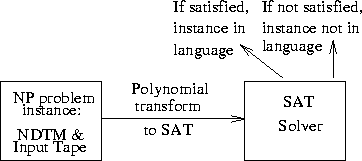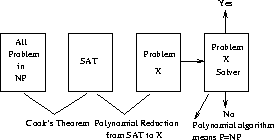36.5-5 Prove that Hamiltonian Path is NP-complete.
The easiest argument says that G contains a HP but no HC iff (x,y)
in G such that adding edge (x, y) to G causes to have a HC,
so calls to a HC function solves HP.
The cleanest proof modifies the VC and HC reduction from the book:
Approximating Vertex Cover
As we have seen, finding the minimum vertex cover is NP-complete. However, a very simple strategy (heuristic) can get us a cover at most twice that of the optimal.
While the graph has edges
pick an arbitrary edge v, u
add both u and v to the cover
delete all edges incident on either u and v
If the graph is represented by an adjacency list this can be implemented in O(m+n) time.
This heuristic must always produce cover, since an edge is only deleted when it is adjacent to a cover vertex.
Further, any cover uses at least half as many vertices as the greedy cover.
No two of these edges share a vertex. Therefore, any cover of just these edges must include one vertex per edge, or half the greedy cover!
Things to Notice
Example: Pick one of the two vertices instead of both (after all, the middle edge is already covered) The optimal cover is one vertex, the greedy heuristic is two vertices, while the new/bad heuristic can be as bad as n-1.
The Euclidean Traveling Salesman
In the traditional version of TSP - a salesman wants to plan a drive to visit all his customers exactly once and get back home.
Euclidean geometry satisfies the triangle
inequality, .
TSP remains hard even when the distances are Euclidean distances in the plane.
However, we can approximate the optimal Euclidean TSP tour using minimum spanning trees.
Claim: the cost of a MST is a lower bound on the cost of a TSP tour.
Why? Deleting any edge from a TSP tour leaves a path, which is a tree of weight at least that of the MST!
If we were allowed to visit cities more than once, doing a depth-first traversal of a MST, and then walking out the tour specified is at most twice the cost of MST. Why? We will be using each edge exactly twice.
However, how can we avoid revisiting cities?
We can take a shortest path to the next unvisited vertex. The improved tour is 1-2-3-5-8-9-6-4-7-10-11-1. Because we replaced a chain of edges by the edge, the triangle inequality ensures the tour only gets shorter. Thus this is still within twice optimal!
37.1-3 Give an efficient greedy algorithm that finds an optimal vertex cover of a tree in linear time.
Every tree has at least two leaves, meaning that there is always an edge which is adjacent to a leaf. Which vertex can we never go wrong picking? The non-leaf, since it is the only one which can also cover other edges!
After trimming off the covered edges, we have a smaller tree. We can repeat the process until the tree as 0 or 1 edges. When the tree consists only of an isolated edge, pick either vertex.
All leaves can be identified and trimmed in O(n) time during a DFS.
Formal Languages and the Theory of NP-completeness
The theory of NP-completeness is based on formal languages and Turing machines, and so we will must work on a more abstract level than usual.
For a given alphabet of symbols 0, 1, &, we can form an
infinite set of strings or words by arranging them in any
order: `&10', `111111',`&&&', and `&'.
A subset of the set of strings over some alphabet is a formal language.
Formal language theory concerns the study of how powerful a machine you need to recognize whether a string is from a particular language.
Example: Is the string a binary representation of a even number? A simple finite machine can check if the last symbol is zero:
Observe that solving decision problems can be thought of as formal language recognition. The problem instances are encoded as strings and strings in the language if and only if the answer to the decision problem is YES!
What kind of machine is necessary to recognize this language? A Turing Machine!
A Turing machine has a finite-state-control (its program), a two way infinite tape (its memory) and a read-write head (its program counter)
So, where are we?
Each instance of an optimization or decision problem can be encoded as string on some alphabet. The set of all instances which return True for some problem define a language.
Hence, any problem which solves this problem is equivalent to a machine which recognizes whether an instance is in the language!
The goal of all this is going to be a formal way to talk about the set of problems which can be solved in polynomial time, and the set that cannot be.
Non-deterministic Turing Machines
Suppose we buy a guessing module peripherial for our Turing machine, which looks at a Turing machine program and problem instance and in polynomial time writes something it says is an answer. To convince ourselves it really is an answer, we can run another program to check it.
Ex: The Traveling Salesman Problem
The guessing module can easily write a permutation of the vertices in polynomial time. We can check if it is correct by summing up the weights of the special edges in the permutation and see that it is less than k.
The class of languages we can recognize in time polynomial in the length of the string or a non-deterministic Turing Machine is called NP.
Clearly, , since for any DTM program we can run it on a
non-deterministic machine, ignore what the guessing module is doing,
and it will just as fast.
P ?= NP
Observe that any NDTM program which takes time P(n) can
simulated in
time on a deterministic machine, by running the checking
program
times, once on each possible guessed string.
The $10,000 question is whether a polynomial time simulation exists, or in other words whether P=NP?. Do there exist languages which can be verified in polynomial time and still take exponential time on deterministic machines?
This is the most important question in computer science. Since proving an exponential time lower bound for a problem in NP would make us famous, we assume that we cannot do it.
What we can do is prove that it is at least as hard as any problem in NP. A problem in NP for which a polynomial time algorithm would imply all languages in NP are in P is called NP-complete.
Turing Machines and Cook's Theorem
Cook's Theorem proves that satisfiability is NP-complete by reducing all non-deterministic Turing machines to SAT.
Each Turing machine has access to a two-way infinite tape (read/write) and a finite state control, which serves as the program.
We know a problem is in NP if we have a NDTM program to solve it in worst-case time p[n], where p is a polynomial and n is the size of the input.
Cook's Theorem - Satisfiability is NP-complete!
Proof: We must show that any problem in NP is at least as hard as SAT. Any problem in NP has a non-deterministic TM program which solves it in polynomial time, specifically P(n).
We will take this program and create from it an instance of satisfiability such that it is satisfiable if and only if the input string was in the language.
Our transformation will use boolean variables to maintain the state of the TM:
Variable Range Intended meaning Q[i, j]
At time i, M is in
state
H[i,j]
At time i, the read-write head
is scanning tape square j S[i,j,k]
At time i, the contents of
tape square j is symbol
Note that there are literals, a polynomial
number if p(n) is polynomial.
We will now have to add clauses to ensure that these variables takes or the values as in the TM computation.
The group 6 clauses enforce the transition function of the machine. If the read-write head is not on tape square j at time i, it doesn't change ....
There are literals and
clauses in all,
so the transformation is done in polynomial time!
Polynomial Time Reductions
A decision problem is NP-hard if the time complexity on a deterministic machine is within a polynomial factor of the complexity of any problem in NP.
A problem is NP-complete if it is NP-hard and in NP. Cook's theorem proved SATISFIABILITY was NP-hard by using a polynomial time reduction translating each problem in NP into an instance of SAT:

The proof of Cook's Theorem, while quite clever, was certainly difficult and complicated. We had to show that all problems in NP could be reduced to SAT to make sure we didn't miss a hard one.
But now that we have a known NP-complete problem in SAT. For any other problem, we can prove it NP-hard by polynomially transforming SAT to it!

Finding the Optimal Spouse
For example, if the input permutation is
we see (3,1,2) after three candidates.
Picking the first or last candidate gives us a probability of 1/n of getting the best.
Since we seek maximize our chances of getting the best, it never pays to pick someone who is not the best we have seen.
The optimal strategy is clearly to sample some fraction of the candidates, then pick the first one who is better than the best we have seen.
But what is the fraction?
For a given fraction 1/f, what is the probability of finding the best?
Suppose i+1 is the highest ranked person in the first n/f candidates. We win whenever the best candidate occurs before any number from 2 to i in the last n (1- 1/f) / f candidates.
There is a 1/i probability of that, so,
In fact, the optimal is obtained by sampling the first n/e candidates.